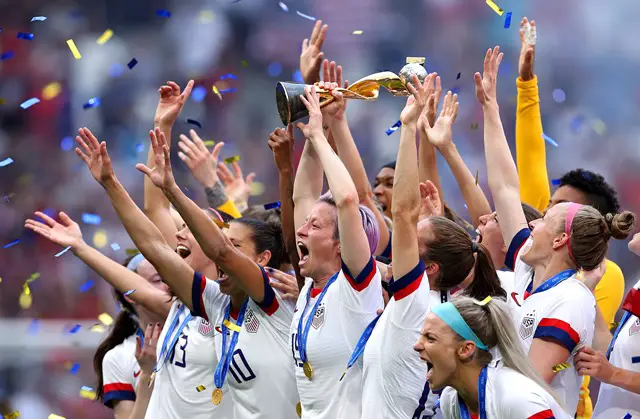The numbers simply kept increasing as the women’s soccer players gazed at their laptop displays Monday night as the new labor contract was disclosed to them. Here’s a couple thousand bucks. Thousands of dollars were over there. The statistics had quickly climbed into the millions, and the race for equal pay was as close as a NASCAR race at WWTR.
What they summed up to was something that many of the players had fought for their whole careers: equal compensation.
That fact was enshrined in historic contracts with the United States Soccer Federation on Wednesday, ensuring that soccer players representing the men’s and women’s national teams in international matches and competitions will be paid equally for the first time.
The agreements contain a clause, thought to be the first of its kind, in which the teams will combine the uneven prize money payouts U.S. Soccer receives from FIFA, the international soccer’s governing body, for their participation in the quadrennial World Cup. Beginning with the men’s tournament in 2022 and the women’s tournament in 2023, that money will be split evenly among the members of both teams.
How Long was the Process?
The agreements were struck just over six years after a group of stars from the World Cup-winning USWNT launched a campaign to end what they claimed was years of salary discrimination against female players by US Soccer. The athletes claimed that despite winning world championships and Olympic gold medals, they had been paid less than their male colleagues for decades.
The spat about per diems and salary eventually turned into a federal lawsuit in which the ladies accused US Soccer of “institutionalized gender discrimination.” While the women failed in federal court in 2020 when a judge dismissed their basic claims, they finally gained equal pay at the negotiation table, thanks to a final push from the men’s side.
The men’s team, in fact, paved the door to an agreement late last year when they secretly agreed to combine some of the millions of dollars in World Cup bonus money that they have typically earned with the modest sums the women’s team receives from their own title.
As early as next season, the two clubs may pool and share $20 million or more. This is on top of match payouts, which are estimated to total $450,000 per year on average — and double or more in years with World Cup extra money.
As the two sides battled in courtrooms and negotiating sessions over the years, the dispute sparked heated — and personal — debates about personal privacy, workplace equality, and basic fairness, and drew support (and second-guessing) from a diverse group of presidential candidates, professional athletes, and Hollywood celebrities — not all of whom were supportive of the women’s pay equity campaign.
Related: Incredible Season: 5 Reasons Why Real Madrid Won The Title
How Big of a Problem was it?
Men’s and women’s pay disparities have been one of soccer’s most controversial problems in recent years, especially after the American women won consecutive World Cup titles in 2015 and 2019, but the men failed to qualify for the 2018 event. The women’s team, which includes some of the most well-known athletes in the world, has increased and magnified its struggle in court papers, news media appearances, and on the sport’s biggest platforms over the years.
Different contracts, uneven prize money, and other financial peculiarities muddied the salary disparities between men’s and women’s teams, confounding the capacity of national regulating organizations like U.S. Soccer to settle the inequalities.
Despite this, the federation eventually agreed to a more equitable arrangement. To do so, US Soccer will pay out millions of dollars in additional match bonuses, pooled prize money, and new revenue-sharing agreements to the finest players in the country. These deals will provide each team a piece of U.S. Soccer’s tens of millions of dollars in annual commercial earnings from sponsors, broadcasters, and other partners.
U.S. Soccer has committed to single-game payouts of $18,000 per player for games won in most matches, and as much as $24,000 per game for wins at some key tournaments, confirming the men’s and women’s national teams’ standing as two of the highest-paid national teams in the world. And the federation will provide 90 percent of the money it receives from FIFA for sending teams to the next two World Cups to the men and women on those teams.
How Big of a Move is This?
The prize money split is a significant concession by the American men, who had previously received the lion’s share of U.S. Soccer’s multimillion-dollar awards, and a possible seven-figure bonanza for the women. For example, the 24 teams competing in the 2019 Women’s World Cup in France played for a $30 million prize pool; the 32 men’s teams competing in Qatar in November will share $450 million.
The team’s readiness to share with some of the money, on the other hand, eliminated the one seemingly insurmountable impediment to an agreement that the federation and the players had long agreed on.
While some of the women applauded the men’s readiness to close the greatest pay gaps, veterans of the equal pay battle — and the C.B.A. negotiations — were more cautious in their remarks.
Despite its high price tag, the new equal pay policy will have incalculable value for all parties involved, as it will put an end to a six-year battle that has tarnished the federation’s reputation, jeopardized U.S. Soccer’s relationships with key sponsors, and cost millions of dollars in legal fees on all sides.
It may be simpler for the federation to acquire new sponsors and repair connections with its most notable players if the dispute is resolved peacefully rather than in court. U.S. Soccer has basically motivated its best stars to serve as partners in exploring new methods to enhance those cash streams by paying them a percentage of its commercial profits.
And salary disparities between men and women will persist: Individual player earnings will continue to be influenced by injuries, coaching choices, and even the amount of games played by each club.
The accords, though, might provide an immediate reward for the most notable American female players by unlocking a $24 million settlement, mostly for retroactive pay, that they negotiated with U.S. Soccer in February to settle the gender discrimination complaint. That one-time payout was predicated on the teams agreeing to new collective bargaining agreements that established equal compensation.
With the new agreements in place, US Soccer may now seek a judge’s permission to begin cutting checks.





